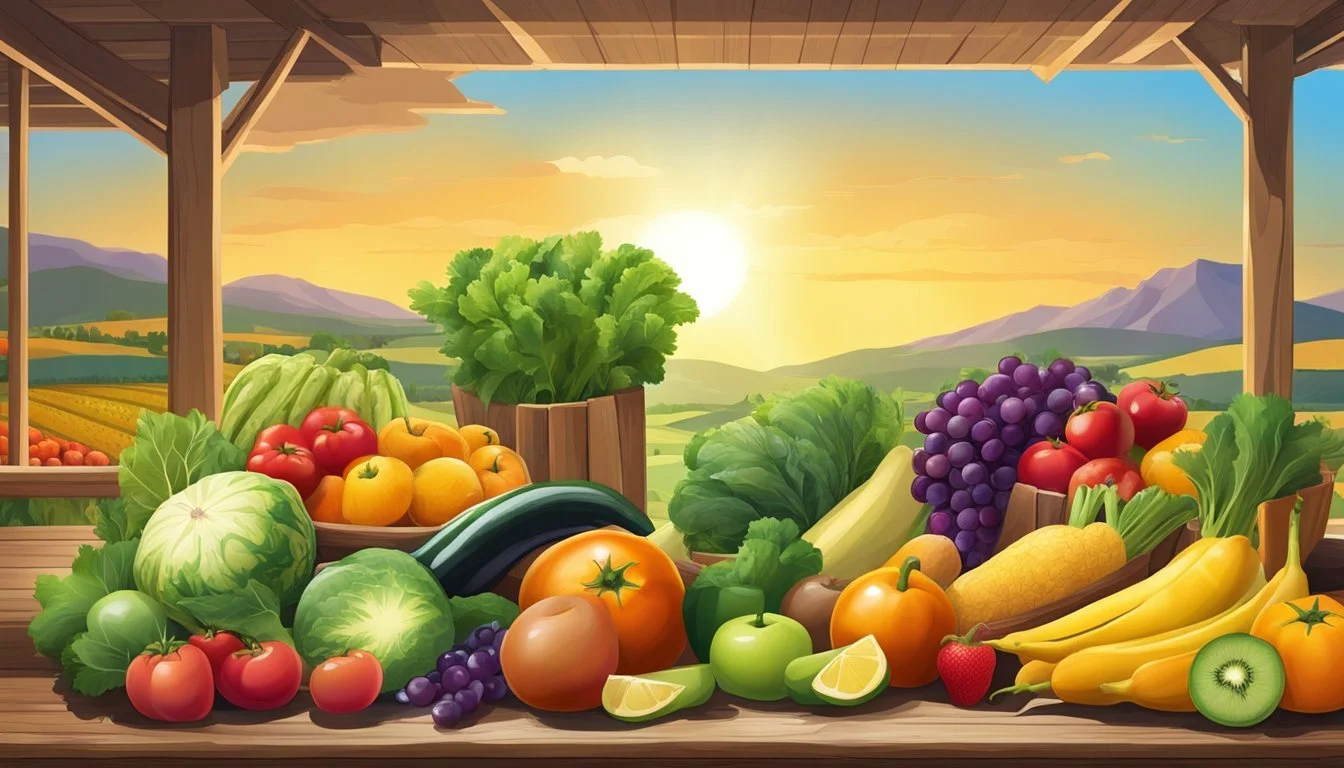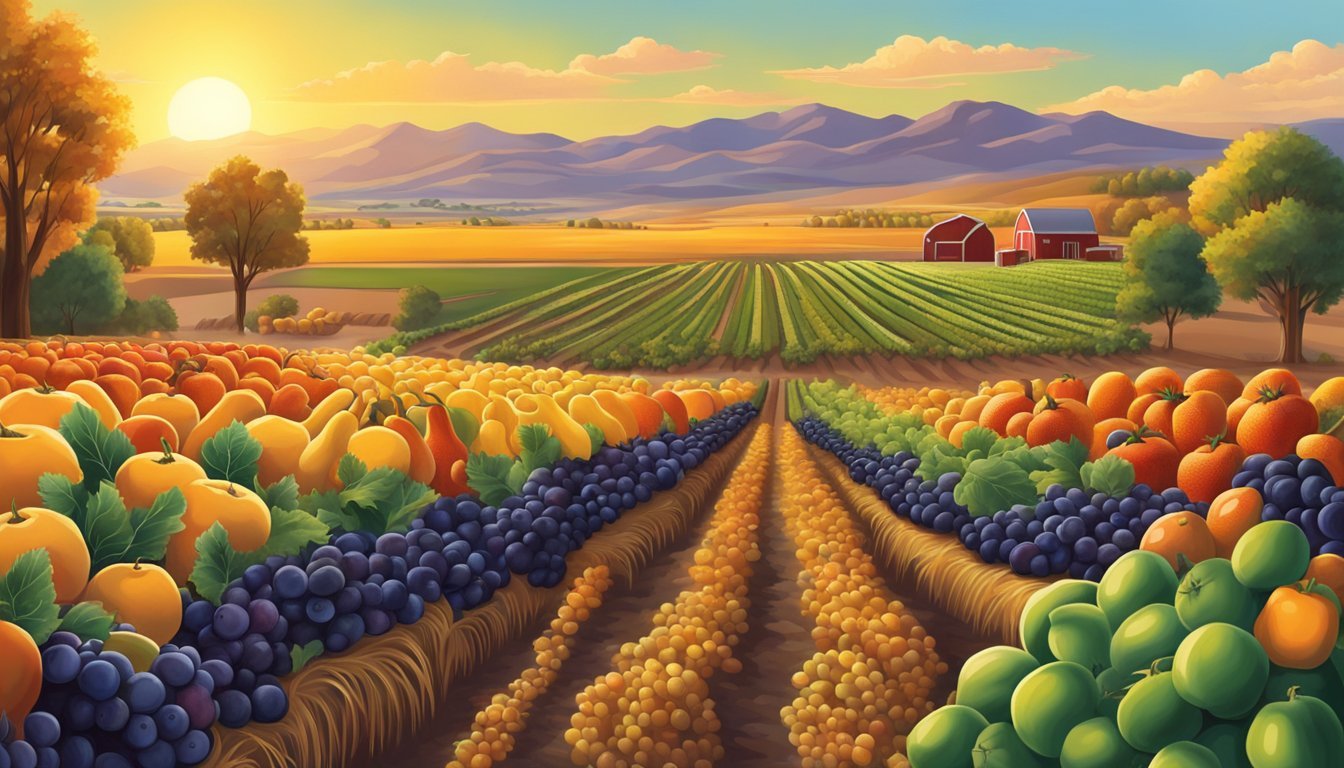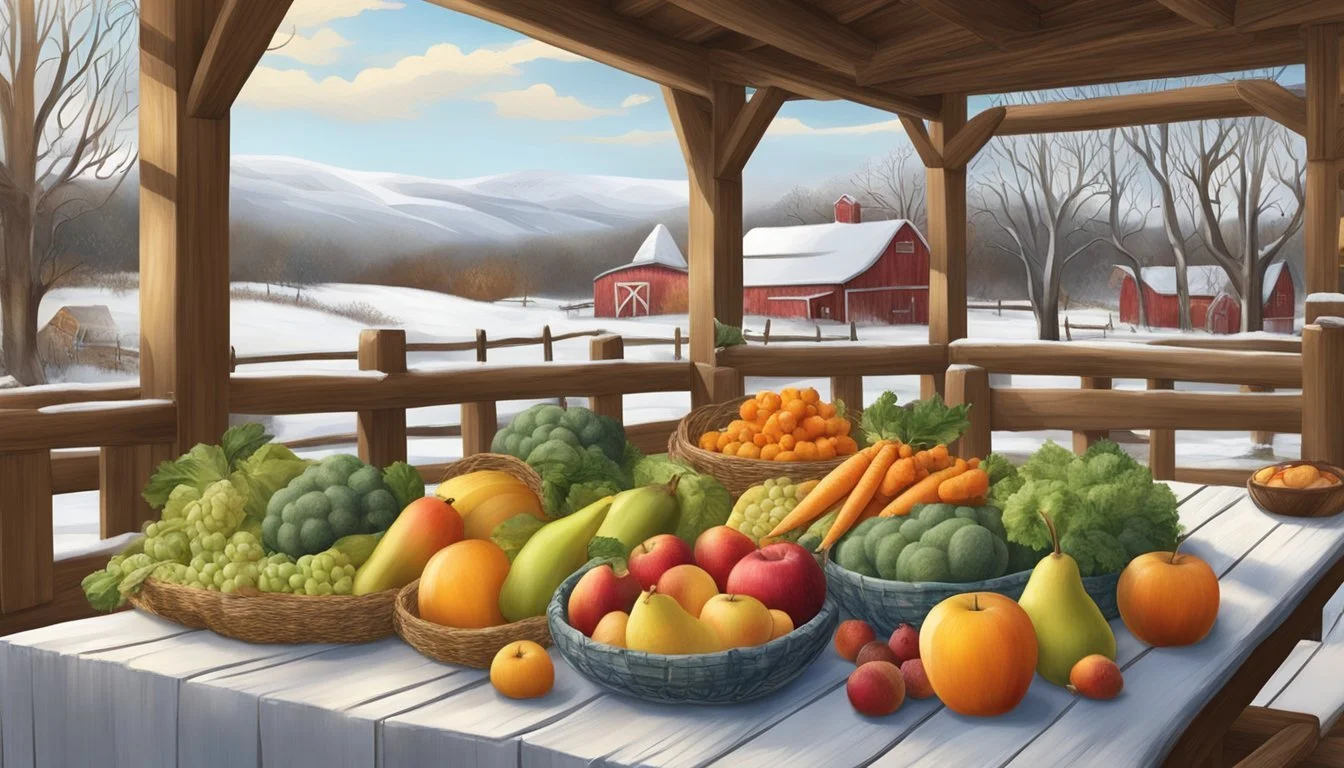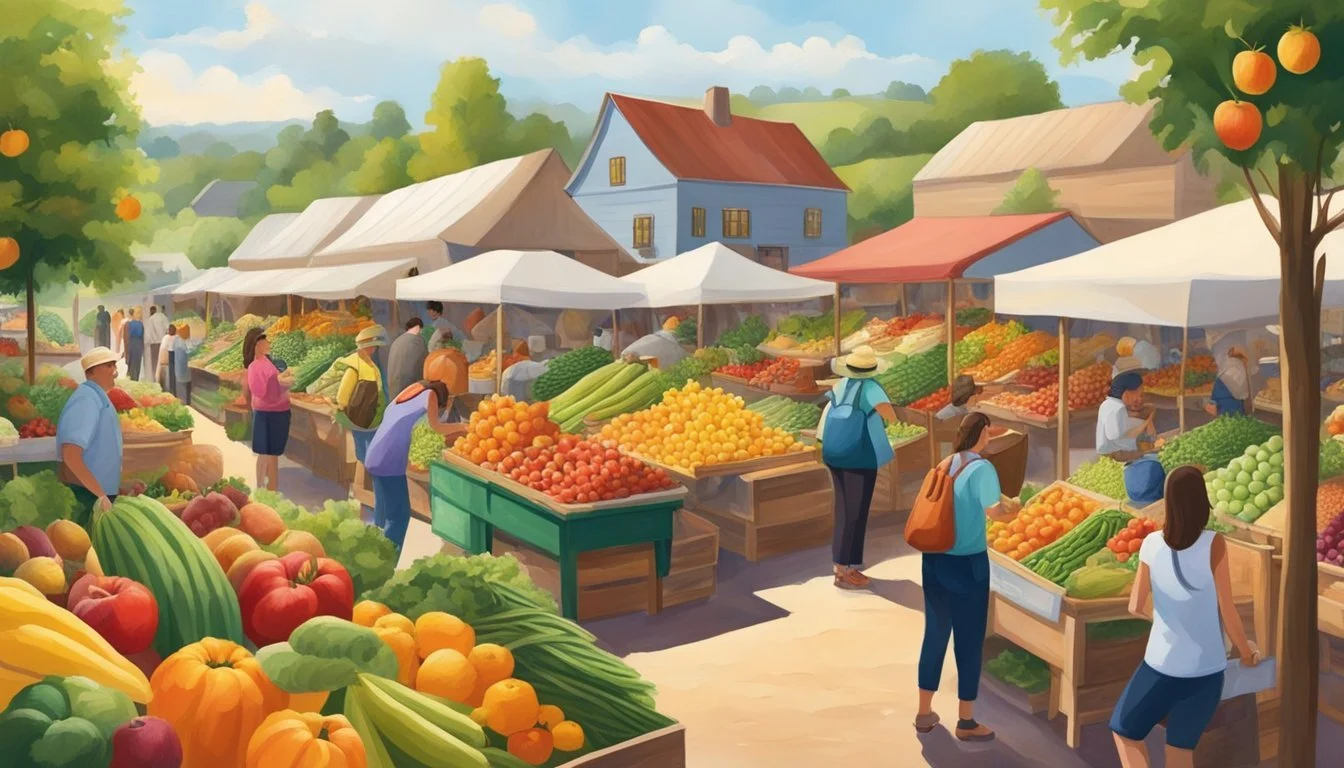Nevada Seasonal Fruit & Veg Guide
Your Year-Round Companion
Nevada's diverse climate presents unique opportunities for its agriculture, offering a variety of seasonal produce that supports the farm-to-table movement. Encompassing regions with differing temperature extremities and dryness, Nevada's agricultural calendar is a testament to the adaptability of its farmers and the richness of its land. This guide aims to outline the rhythm of harvest seasons, pinpointing when fruits and vegetables reach their peak freshness and thus, when they're best to consume directly from Nevada's farms.
Farm-to-table, a term synonymous with freshness, sustainability, and support for local producers, resonates well in Nevada where the agricultural community thrives on providing freshly-picked produce to local consumers. The harvest chart for Nevada reflects not only the seasons but also the distinct growing zones within the state. This understanding allows consumers to make informed choices about their produce, ensuring a connection to the cycle of growth and harvest that's rooted in their own backyard.
As the seasons shift, so does the landscape of available fruits and vegetables in Nevada. From the tender shoots of asparagus (how long does asparagus last?) in the spring to the sweetness of cantaloupes in the summer, and the earthy richness of root vegetables in the cooler fall months, the state offers a bounty that changes with the time of year. Keeping abreast of these changes is not only beneficial for the palate but also supports local economies and promotes a sustainable lifestyle that is in harmony with the natural offerings of the region.
What’s in Season in Nevada Right Now?
Understanding Nevada's Growing Seasons
Nevada's diverse climate requires an understanding of the regional growing seasons to optimize the cultivation and harvest of fruits and vegetables. This guide breaks down the seasonal availability by segments, ensuring consumers and growers know when to expect the freshest local produce.
Spring Harvest
During spring, Nevada witnesses a crisp transition from cold winter days to more temperate weather, allowing for the first sowing and harvesting of the year. Spring crops typically include:
Asparagus
Artichokes (how long do artichokes last?)
Radishes
Spinach
Lettuce
Summer Bounty
The summer months bring heat and longer days, creating an ideal environment for a variety of crops. In Nevada, this season is known for producing:
Melons like cantaloupe and watermelon
Stone fruits such as peaches and cherries
Tomatoes
Green beans
Corn
Autumn Transition
As temperatures cool in fall, harvesting in Nevada shifts to include more robust, late-season crops. The typical autumnal produce includes:
Apples
Pears
Squashes
Pumpkins
Root vegetables like beets and carrots
Winter Selections
Though quieter, the winter season in Nevada can still yield produce that endures the cold. Some winter-hardy options are:
Kale
Brussel sprouts
Cabbage
Winter greens
Each season in Nevada reflects specific regional conditions that affect the quality and availability of fruits and vegetables. This guide serves as a tool for both consumers and growers to navigate these seasonal nuances with confidence.
Spring Seasonal Fruits and Vegetables
As Nevada welcomes spring, the season ushers in a delightful array of fresh fruits and vegetables. Farmers' markets and local gardens begin to offer a variety of produce, adding freshness to meals and supporting local agriculture.
Fruits to Enjoy
During Nevada's spring months, strawberries often steal the spotlight. Typically peaking around April, these berries are known for their sweet, juicy flavor, making them a popular choice for both fresh eating and desserts. Though not as commonly grown, apricots may also start to make an appearance by late spring, providing a succulent option packed with vitamins.
Strawberries: Begin to ripen in April; juiciness and sweet flavor peak this season.
Apricots: Harvest starts in late spring; enjoyed for their sweet-tart balance.
Vegetables in Harvest
The verdant fields of Nevada produce an abundance of asparagus, which is one of the first vegetables to be harvested in spring. It’s sought after for its tender stalks and versatility in dishes. Peas also come into season, with their plump pods signaling readiness for harvest. Spring greens, including a variety of lettuces and spinach, are at their most tender and flavorful during this season, ideal for fresh, crisp salads.
Asparagus: Harvest begins in March; prized for its tender, flavorful stalks.
Peas: Sweet, plump pods become ready to pick in spring.
Greens:
Lettuce: Various types flourish in spring; prized for its crispness.
Spinach: Tender and flavorful; a staple for salads and cooked dishes.
Summer's Peak: Fruits and Vegetables
During the summer months, Nevada's agricultural output reaches its zenith, offering a vibrant array of fruits and vegetables at their freshest and most flavorful.
Summer Fruit Varieties
Nevada’s summer heat supports a bountiful fruit harvest. Watermelons and peaches are among the quintessential summer fruits, both known for their juicy, refreshing quality. Nectarines, with their smooth skin, offer a similarly succulent taste. These fruits typically reach their peak from June to September.
Watermelon: Sweet and hydrating, peak season in July and August.
Peaches: Juicy with a soft fuzz, prime harvesting in July and August.
Nectarines: Smooth-skinned and sweet, best in July and August.
Summer Vegetable Harvest
Vegetables also thrive under the Nevada sun. Tomatoes, bursting with flavor, are harvested throughout the summer months, well into September. For those who enjoy crisp vegetables, cucumbers are an essential pick. They maintain their peak freshness alongside beans, which are known for their versatility in dishes. Corn and summer squash are summer staples, with corn being a sweet, staple crop and squash providing a mild flavor perfect for an array of summer recipes.
Tomatoes: Ripe and full-flavored from June to September.
Cucumbers: Crisp and cool, harvested in July and August.
Beans: Snap or string varieties, available from July to September.
Corn: Sweet kernels, peak harvest from July to August.
Summer Squash: Mild and tender, perfect from June to August.
Fall Harvest in Nevada
As the Nevada temperature cools down, the fall season beckons a diverse array of fresh produce. During this time, farmers' markets start to display the rich, warm colors of autumn's bounty.
Fruits of the Season
In the fall, apples and pears become the center of attention in Nevada’s orchards. One can find a variety of apples, including the crisp 'Golden Delicious' and the ever-popular 'Red Delicious.' The pear trees, too, bear fruit, offering juicy options for fresh eating or preserving.
Apples: September to October
Pears: Late August to October
Vegetables to Savor
Nevada's cooler fall climate is conducive to growing a selection of nourishing vegetables. Pumpkins signal the arrival of fall and are ready for harvest alongside a variety of squash, such as butternut and acorn. Root vegetables like carrots sweeten with the frost, while Brussels sprouts (how long do brussels sprouts last?)thrive in the chillier weather.
Pumpkins: October
Squash: October to November
Carrots: October to November
Brussels sprouts: October to November
This season, local produce reaches its peak in flavor and nutrition, ready to be enjoyed in hearty, fall dishes.
Winter Produce Guide
In the winter months, Nevada still offers a variety of fresh produce. Farmers markets and local growers provide an array of fruits and vegetables that thrive in cooler temperatures.
Citrus and Storage Fruits
Citrus fruits come into season in Nevada during the winter, offering a fresh burst of flavor and vitamin C.
Oranges: Available and sweet during the winter season.
Lemons: A staple citrus that is typically ready for harvest throughout winter.
Storage fruits that were picked during their harvest season remain excellent for consumption during the winter due to their longer shelf life.
Apples: Stored from their harvest can last well into the winter months.
Hearty Winter Vegetables
Nevada's winter climate is suitable for growing a variety of hearty vegetables that can withstand the colder temperatures.
Kale: A robust leafy green that thrives in cooler weather.
Winter Squash: Varieties such as butternut and acorn squash are available and excellent for roasting.
Root Vegetables: These include carrots and beets; they store well and are ideal for hearty winter dishes.
Squash: Alongside winter varieties, squash like zucchini can be grown in controlled environments.
Farmers in Nevada continue to cultivate these resilient varieties contributing to the local farm-to-table movement, even during the chillier winters.
Buying Local: Farmers Markets and Farms
When residents in Nevada look to buy fresh, seasonal produce, they often turn to local farmers markets and farms. These venues provide access to fruits and vegetables at the peak of their flavor and nutritional value.
Finding the Right Market
In Nevada, one can find a variety of farmers markets operating year-round, though the selection may vary by season. For example, The Las Vegas Farmers Market operates every weekend and offers a wide array of fresh produce, local honey, and fresh eggs. Similarly, to locate farmers markets or individual farms in Henderson or other regions within Nevada, residents can use resources like the LocalHarvest website to find operations like Farm 2 Vegas Table Co-op, which may offer a diverse range of locally sourced products.
Benefits of Local Produce
Purchasing produce from local Nevada farmers has multiple benefits. Firstly, consumers get to enjoy freshness as the time from farm to table is significantly reduced compared to produce that is shipped from out-of-state. Additionally, supporting local farmers and markets can boost the state's economy, ensuring the livelihood of local farmers. Fresh52 is one such market where local artisans and farmers can sell their produce directly to consumers, ensuring the produce is as fresh as it can be.
Buying local also provides environmental benefits, reducing the carbon footprint associated with long-distance transportation of food products. Consumers can rely on venues like THE LAS VEGAS FARM for eggs, fruit, vegetables, and honey that are produced sustainably within the state. Moreover, by frequenting local farmers and markets, consumers often have direct access to the farmers themselves, who can provide invaluable insights into the produce, such as growing practices and recipe suggestions.
Seasonal Cooking and Preservation
Embracing seasonal ingredients not only enhances flavor but also fosters a deeper connection with the local food cycle. It allows one to utilize preservation techniques to extend the bounty of the season throughout the year.
Cooking with Seasonality in Mind
When it comes to seasonal cooking, using ingredients at their peak ensures maximum flavor and nutritional value. For example, Nevada's apple harvest, spanning from August through October, presents an opportunity to enjoy these fruits when they're especially crisp and juicy. Chefs and home cooks alike benefit from incorporating fresh, local produce into their recipes, delivering dishes that reflect the essence of the current season.
Techniques:
Roasting brings out the natural sweetness in root vegetables harvested in the cooler months.
Grilling enhances the flavors of summer's zucchini and peppers.
Quick pickling is an easy method to add a flavor boost to seasonal vegetables like radishes and green beans.
Preserving the Harvest
Preservation extends the life of seasonal produce and allows enjoyment of their flavors throughout the year. An array of methods can be employed depending on the type of fruit or vegetable at hand.
Data shows that proper preservation methods can maintain much of the taste and nutrition of fresh produce:
Freezing: Apricots and berries freeze well, maintaining quality for smoothies or baking.
Canning: Tomatoes harvested in late summer can be canned as sauces or salsas.
Drying: Herbs thrive in Nevada's climate and can be dried to use in seasoning.
One must adhere to safe preservation practices to ensure the quality and safety of preserved foods. Proper canning techniques avoid the risk of foodborne illnesses, and freezing requires attention to temperature control to prevent freezer burn.









